Impact of Student Interventions on Urban Greening Processes
Abstract
1. Introduction
1.1. Greening the City
1.2. Changing the Socio-Ecological System
2. Materials and Methods
3. Results
3.1. Enschede
3.1.1. Social, Economic and Political Setting
3.1.2. Resource System: The City District
3.1.3. Resource Units
3.1.4. Related Ecosystems
3.1.5. Governance System
3.1.6. Actors
3.1.7. Interactions
3.1.8. Outcomes
3.2. Haarlem
3.2.1. Social, Economic and Political System
3.2.2. Resource System: The City District
3.2.3. Resource Units
3.2.4. Governance System
3.2.5. Actors
3.2.6. Interactions
3.2.7. Outcomes
4. Discussion
4.1. Factors Causing Change in the Cases’ Socio-Ecological Systems
4.2. Reflection on the Learning Process and Theory
Funding
Acknowledgments
Conflicts of Interest
Appendix A
| Criteria for Mapping a Socio-Ecological System [13]. | Contribution of Students to Changing the Socio-Ecological System | |
|---|---|---|
| Social, economic and political settings (mostly city level) | S1 Economic development S2 Demographic trends S3 Political stability S4 Other governance systems S5 Markets S6 Media organizations S7 Technology | S3 Indirect to new political coalitions (see outcomes) S6 Contribution to PR (radio, newspaper) |
| Resource system (the city district) | RS1 Sector (e.g. water, forests, pasture) RS2 Clarity of the system boundaries RS3 Size of the resource system RS4 Human-constructed facilities RS5 Productivity of the system RS6 Equilibrium properties RS7 Predictability of system dynamics RS8 Storage characteristics RS9 Location | RS2 Mapping ecological connectivity with other systems RS3 Mapping of green infrastructure RS4 Mapping of buildings and paved area RS8: Rudimentary mapping of water storage capacity |
| Resource unit (ecological elements) | RU1 Resource unit mobility RU2 Growth or replacement rate RU3 interaction among resource units RU4 Economic value RU5 Number of units RU6 Distinctive characteristics RU7 Spatial and temporal distribution | RU3 Mapping ecological connectivity within the system RU6 Mapping different types of ecological elements RU7 Mapping spatial distribution of the different ecological elements |
| Related ecosystems | ECO1 Climate patterns ECO2 Pollution patterns ECO3 Flows into and out of SES | ECO1 Detecting heat islands ECO3 Mapping connectivity outside resource system |
| Interaction (within and outside resource system) | I1 Harvesting I2 Information sharing I3 Deliberation processes I4 Conflicts I5 Investment activities I6 Lobbying activities I7 Self-organizing activities I8 Networking activities I9 Monitoring activities I10 Evaluative activities | I2 Organizing meetings, workshops, presentations: matching local knowledge with scientific knowledge I3 Supporting local actors by organizing workshops with stakeholders. Showing the value of connecting social values (e.g., liveability) and ecological values (integrated solutions I4 Intermediary in potential conflict situations between stakeholders I6 Supporting lobbying by providing knowledge about the social and ecological system I7 Entrance of students triggers self-organizing activities I8 Organizing meetings, workshops, presentations. Connecting different stakeholders I9 Monitoring the ecosystem and social wishes/demands I10 First steps in supporting citizen science (counting birds, plants, insects) |
| Governance systems | GS1 Government organizations GS2 Nongovernment organizations GS3 Network structure GS4 Property-rights systems GS5 Operational-choice rules GS6 Collective-choice rules GS7 Constitutional-choice rules GS8 Monitoring and sanctioning rules | GS3 Strengthening the network |
| Actors | A1 number of relevant actors A2 Socioeconomic attributes A3 History and past experiences A4 Location A5 Leadership/entrepreneurship A6 Norms (trust – reciprocity)/social capital A7 Knowledge of SES/mental models A8 Importance of resource (dependence) A9 Technologies available | A1 Student activities lead to increased amount of connected actors. A2 Students invest time and add scientific knowledge A5 The entrance of students provokes leadership because the project needs to be organized. It also encourages the local actors to become a change agent by adding knowledge, network. A6 Students are trusted by almost everybody, they open doors for other actors. Increasing enthusiasm for green solutions by other stakeholders A7 Knowledge about the effect of human beings on the ecological system A8 Stressing the importance of the ecological infrastructure for the actors involved A9 Providing knowledge about maintenance |
| Outcomes | O1 Social performance measures O2 Ecological performance measures O3 Externalities to other SESs | O1 Contribution to empowerment (in the resource system and in political setting) by adding knowledge, network, activities (buzz) O2 Contributions to planning ecological infrastructure and integrating social (e.g., liveability) and ecological needs. O3 Contribution to exporting knowledge to other districts |
References
- Forest Research. Benefits of Green Infrastructures; Forest Research: Farnham, UK, 2010. [Google Scholar]
- Duinker, P.N.; Ordóñez, C.; Steenberg, J.W.N.; Miller, K.H.; Toni, S.A.; Nitoslawski, S.A. Trees in Canadian Cities: Indispensable Life Form for Urban Sustainability. Sustainability 2015, 7, 7379–7396. [Google Scholar] [CrossRef]
- Derkzen, M.L.; Van Teeffelen, A.J.A.; Nagendra, H.; Verburg, P.H. Shifting roles of urban green space in the context of urban development and global change. Curr. Opin. Environ. Sustain. 2017, 29, 32–39. [Google Scholar] [CrossRef]
- Xing, Y.; Jones, P.; Donnison, I. Characterization of Nature-based solutions for the build environment. Sustainability 2017, 9, 149. [Google Scholar] [CrossRef]
- Sturiale, L.; Scuderi, A. The Evaluation of Green Investments in Urban Areas: A Proposal of an eco-social-green Model of the City. Sustainability 2018, 10, 4541. [Google Scholar] [CrossRef]
- Parker, J.; Zingoni de Baro, M.E. Green infrastructure in the urban environment: A systematic quantitative review. Sustainability 2019, 11, 3182. [Google Scholar] [CrossRef]
- Mattijssen, T.J.M.; Van der Jagt, A.P.N.; Buijs, A.E.; Elands, B.H.M.; Erlwein, S.; Lafortezza, R. The long-term prospects of citizens managing urban green space: From place making to place-keeping? Urban For. Urban Green. 2017, 26, 78–84. [Google Scholar] [CrossRef]
- Stobbelaar, D.J.; Janssen, J.A.M.; Van der Heide, M. Van theorie naar praktijk. In Geïntegreerd Natuur-en Landschapsbeheer: Succesfactoren Voor Het Ontwikkelen van Natuur en Landschap; Stobbelaar, D.J., Janssen, J.A.M., Van der Heide, M., Eds.; Westerlaan Publisher: Lichtenvoorde, The Netherlands, 2018. [Google Scholar]
- Beunen, R.; Duineveld, M.; During, R.; Straver, G.H.M.B.; Aalvanger, A. Reflexivity in performative science shop projects. Gateways Int. J. Commun. Res. Engagem. 2012, 5, 135–151. [Google Scholar] [CrossRef]
- Geier, I. Active Citizenship Learning in Higher Education. Z. Für Hochsch. 2018, 13, 155–168. [Google Scholar] [CrossRef]
- Forester, J. Deliberative Practitioner: Encouraging Participatory Planning Processes; MIT Press: Cambridge, MA, USA, 1999. [Google Scholar]
- Tejedor, G.; Segalàs, J.; Barrón, Á.; Fernández-Morilla, M.; Teresa Fuertes, M.; Ruiz-Morales, J.; Gutiérrez, I.; García-González, E.; Aramburuzabala, P.; Hernández, À. Didactic Strategies to Promote Competencies in Sustainability. Sustainability 2019, 11, 2086. [Google Scholar] [CrossRef]
- McGinnis, M.D.; Ostrom, E. Social-Ecological System Framework: Initial Changes and Continuing Challenges. Ecol. Soc. 2014, 19, 30. [Google Scholar] [CrossRef]
- Ostrom, E. A general framework for analyzing sustainability of social-ecological systems. Science 2009, 325, 419–422. [Google Scholar] [CrossRef] [PubMed]
- Hawe, P.; Shiell, A.; Riley, T. Theorising Interventions as Events in Systems. Am. J. Commun. Psychol. 2009, 43, 267–276. [Google Scholar] [CrossRef] [PubMed]
- Moore, G.F.; Evans, R.E.; Hawkins, J.; Littlecott, H.; Melendez-Torres, G.J.; Bonell, C.; Murphy, S. From complex social interventions to interventions in complex social systems: Future directions and unresolved questions for intervention development and evaluation. Evaluation 2019, 25, 23–45. [Google Scholar] [CrossRef] [PubMed]
- Buijs, A.; Hansen, R.; Van der Jagt, S.; Ambrose-Oji, B.; Elands, B.; Lorance Rallb, E.; Mattijssen, T.; Pauleit, S.; Runhaar, H.; Stahl Olafsson, A.; et al. Mosaic governance for urban green infrastructure: Upscaling active citizenship from a local government perspective. Urban For. Urban Green. 2019, 40, 53–62. [Google Scholar] [CrossRef]
- Schäfer, M.; Hielscher, S.; Haas, W.; Hausknost, D.; Leitner, M.; Kunze, I.; Mandl, S. Facilitating Low-Carbon Living? A Comparison of Intervention Measures in Different Community-Based Initiatives. Sustainability 2018, 10, 1047. [Google Scholar]
- Rocha, E.M. A ladder of empowerment. J. Plan. Educ. Res. 1997, 17, 31–44. [Google Scholar] [CrossRef]
- Fraser, E.D.G.; Dougilla, A.J.; Mabeeb, W.E.; Reeda, M.; MacAlpinec, P. Bottom up and top down. Analysis of participatory processes for sustainability indicator indentification as a pathway to community empowerment and sustainable environmental management. J. Environ. Manag. 2006, 78, 114–127. [Google Scholar] [CrossRef]
- Dempsey, N.; Burton, M. Defining place-keeping: The long-term management of public spaces. Urban For. Urban Green. 2012, 11, 11–20. [Google Scholar] [CrossRef]
- Burton, M.; Smith, H.; Dempsey, N. Place-Keeping: Open Space Management in Practice; Routledge: New York, NY, USA, 2014. [Google Scholar]
- Hasani, K.; Sheikhesmaeili, S. Knowledge Management and employee empowerment A Study of Higher Education Institutions. Kybernetes 2016, 45, 337–355. [Google Scholar] [CrossRef]
- Adamson, D.; Bromiley, R. Community empowerment: Learning from practice in community regeneration. Int. J. Public Sect. Manag. 2013, 26, 190–202. [Google Scholar] [CrossRef]
- Schneider, F.; Steiger, D.; Ledermann, T.; Fry, P.; Rist, S. No-tillage farming: Co-creation of innovation through network building. Land Degrad. Dev. 2010, 23, 242–255. [Google Scholar] [CrossRef]
- Pröpper, I.; Steenbeek, D. De Aanpak van Interactief Beleid: Elke Situatie is Anders; Couthinho: Bussem, The Netherlands, 1999. [Google Scholar]
- Van Dam, R.I.; Salverda, I.E.; During, R. Strategies of citizens’ initiatives in the Netherlands: Connecting people and institutions. Crit. Policy Stud. 2014, 8, 323–339. [Google Scholar] [CrossRef]
- Berwick, D.M. The science of improvement. JAMA J. Am. Med Assoc. 2008, 299, 1182–1184. [Google Scholar] [CrossRef] [PubMed]
- Moore, G.F.; Evans, R.E. What theory, for whom and in which context? Reflections on the application of theory in the development and evaluation of complex population health interventions. SSM Popul. Health 2017, 3, 132–135. [Google Scholar] [CrossRef]
- Von Schönfeld, K.C.; Tan, W.; Wiekens, C.; Janssen-Jansen, L. Unpacking social learning in planning: Who learns what from whom? Urban Res. Pract. 2019. [Google Scholar] [CrossRef]
- Chess, C.; Purcell, K. Public Participation and the Environment: Do We Know What Works? Environ. Sci. Technol. 1999, 33, 2685–2692. [Google Scholar] [CrossRef]
- Mauser, W.; Klepper, G.; Rice, M.; Schmalzbauer, B.S.; Hackmann, H.; Leemans, R.; Moore, H. Transdisciplinary global change research: The co-creation of knowledge for sustainability. Curr. Opin. Environ. Sustain. 2013, 5, 420–431. [Google Scholar] [CrossRef]
- Stobbelaar, D.J.; Hoofwijk, H. Bewonersnatuur in Zundert. Co-creatie en contextualisering van landschapsecologische kennis (Resident’s nature in Zundert; co-creation and contextualization of landscape-ecological knowledge). Landschap 2015, 3, 111–117. [Google Scholar]
- Sara, R.; Jones, M. The university as agent of change in the city: Co-creation of live community architecture. Archnet-IJAR Int. J. Archit. Res. 2018, 12, 326–337. [Google Scholar] [CrossRef]
- De Kruijf, M.; Stobbelaar, D.J. Network Learning as an Educational Principle in Higher Education. Procedia Soc. Behav. Sci. 2015, 186, 694–698. [Google Scholar] [CrossRef][Green Version]
- Beaulieu, R.J. Action Research: Trends and variations. Can. J. Action Res. 2013, 14, 29–39. [Google Scholar]
- MacKinnon, G.R.; Young, D.; Paish, S.; LeBel, S. Preparing Instructional Leaders: Evaluating a Regional Program to Gauge Perceived Effectiveness. Int. J. Educ. Policy Leadersh. 2019, 14, 1. [Google Scholar] [CrossRef]
- Cebrián, G.; Grace, M.; Humphris, D. An Action Research Project for Embedding Education for Sustainable Development in a University Curriculum: Processes and Prospects. In Integrative Approaches to Sustainable Development at University Level; World Sustainability Series; Leal Filho, W., Brandli, L.L., Kuznetsova, O., Paço, A.M.F.D., Eds.; Springer: Berlin/Heidelberg, Germany, 2015; pp. 707–711. [Google Scholar] [CrossRef]
- Ahlers, R.; Hoekman, C.; Lexmond, S.; Peters, W. Wijkvergroening Indische Buurt Noord. Bachelor’s Thesis, University of Applied Sciences Van Hall Larenstein, Velp, The Netherlands, 2019. [Google Scholar]
- Bonekamp, B.; De Donker, K.; Geerts, D.; Kassenberg, M. Een Groene Sportboulevard in Enschede Zuid. Bachelor’s Thesis, University of Applied Sciences Van Hall Larenstein, Velp, The Netherlands, 2019. [Google Scholar]
- Dijkgraaf, I.; Groothuis, L.; Pompert, T.; Meijer, C. Landschapsplan Enschede Noord. Verhoging van de Biodiversiteit in de Hengelosestraat en het Reduceren van de Eikenprocessierups. Bachelor’s Thesis, University of Applied Sciences Van Hall Larenstein, Velp, The Netherlands, 2019. [Google Scholar]
- Hartnack, G.; Boerrigter, J.; De Caes, K.; De Koning, V.; Jissink, A. Landschapsontwikkelingsplan Stadsdeel Enschede West–Havengebied. Bachelor’s Thesis, University of Applied Sciences Van Hall Larenstein, Velp, The Netherlands, 2019. [Google Scholar]
- Hulleman, A.; Kuijvenhoven, J.; Scholte, J.; Terluin, G.; Van der Veen, F. Landschapsplan Varvik-Diekman. Een Onderzoek naar een Duurzamere Inrichting voor de Lanen in Varvik-Diekman. Bachelor’s Thesis, University of Applied Sciences Van Hall Larenstein, Velp, The Netherlands, 2019. [Google Scholar]
- Steutel, R.; Nobre Henriques, M.; Verheijen, L.; Van der Ham, W. Landschapsontwikkelingsplan Enschede Centrum. Bachelor’s Thesis, University of Applied Sciences Van Hall Larenstein, Velp, The Netherlands, 2019. [Google Scholar]
- Li, F.; Liu, X.; Zhang, X.; Zhao, D.; Liu, H.; Zhou, C.; Wang, R. Urban ecological infrastructure: An integrated network for ecosystem services and sustainable urban systems. J. Clean. Prod. 2017, 163, S12–S18. [Google Scholar] [CrossRef]
- Kaikittipoom, P. Establishing Citizen Participation in Real Estate Domain. A Case Study of Campus and Real Estate Division of Delft University of Technology. Master’s Thesis, Delft University, Delft, The Netherlands, 2019. [Google Scholar]
- Jorritsma, L. Mutalist Urbanism: Achieving Mutualism between Urban Development and Strengthening Biodiversity through Nature-Inclusive Urban Planning and Design: The Case of Het Zomerhofkwartier in Rotterdam. MSc Thesis, Urbanism TU Delft, Delft, The Netherlands, 2020. [Google Scholar]
- Gemeente Enschede; Landschap Overijssel. Natuurkansenkaart Enschede. Gericht Investeren in de Natuur. Enschede, The Netherlands, 2016. Available online: https://www.enschede.nl/sites/default/files/natuurkansenkaart.pdf (accessed on 1 March 2020).
- Oranjewoud en Gemeente Enschede. Groenstructuuractieplan 2006–2009. Enschede, The Netherlands, 2005. Available online: https://www.ruimtelijkeplannen.enschede.nl/NL.IMRO.0153.SV00001-0003/db_NL.IMRO.0153.SV00001-0003_1.pdf (accessed on 1 March 2020).
- Gemeente Haarlem. Structuurvisie Openbare Ruimte. Haarlem 2040: Groen en Bereikbaar. Haarlem, The Netherlands, 2017. Available online: https://gemeentebestuur.haarlem.nl/ (accessed on 30 April 2020).
- Internet Redactie Noord Hollands Dagblad. Hevige Regenval Zorgde er Dinsdagavond Voor Dat Straten in Haarlem Blank Stonden. 2019. Available online: https://www.noordhollandsdagblad.nl/cnt/dmf20191001_90941710/straten-overstroomd-in-haarlem-door-hevige-regenval-video?utm_source=google&utm_medium=organic (accessed on 30 April 2020).
- Forino, G.; Von Meding, J.; Brewer, G.J. A Conceptual Governance Framework for Climate Change Adaptation and Disaster Risk Reduction Integration. Int. J. Disaster Risk Sci. 2015, 6, 372–384. [Google Scholar] [CrossRef]
- Van Aalst, M.K.; Cannon, T.; Burton, I. Community level adaptation to climate change: The potential role of participatory community risk assessment. Glob. Environ. Chang. 2008, 18, 165–179. [Google Scholar] [CrossRef]
- Coreau, A.; Guillet, F.; Rabaud, S. The influence of ecological knowledge on biodiversity conservation policies. J. Nat. Conserv. 2018, 46, 97–105. [Google Scholar] [CrossRef]
- Partelow, S. A review of the social-ecological system framework: Applications, methods, modifications, and challenges. Ecol. Soc. 2018, 23, 36. [Google Scholar] [CrossRef]
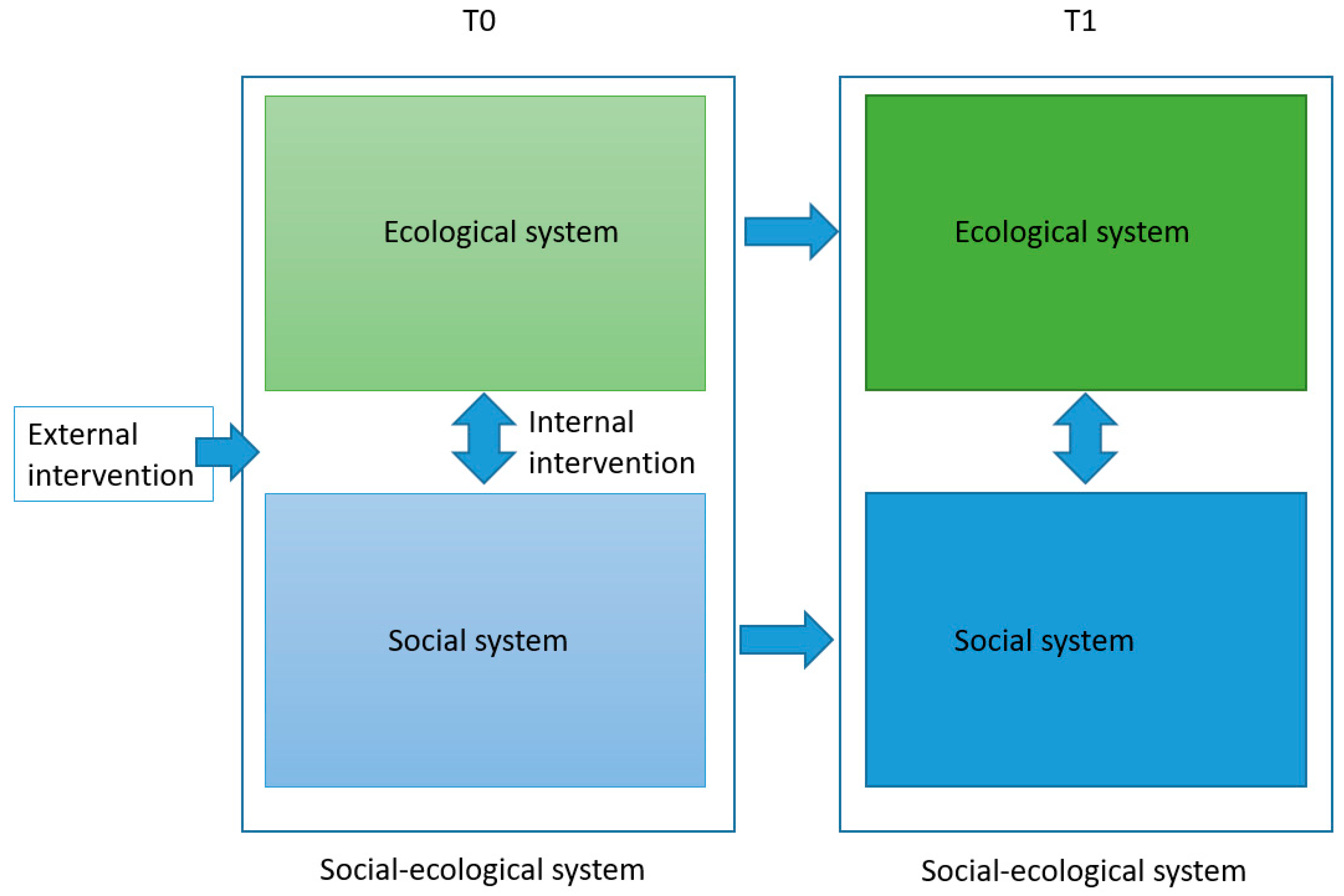
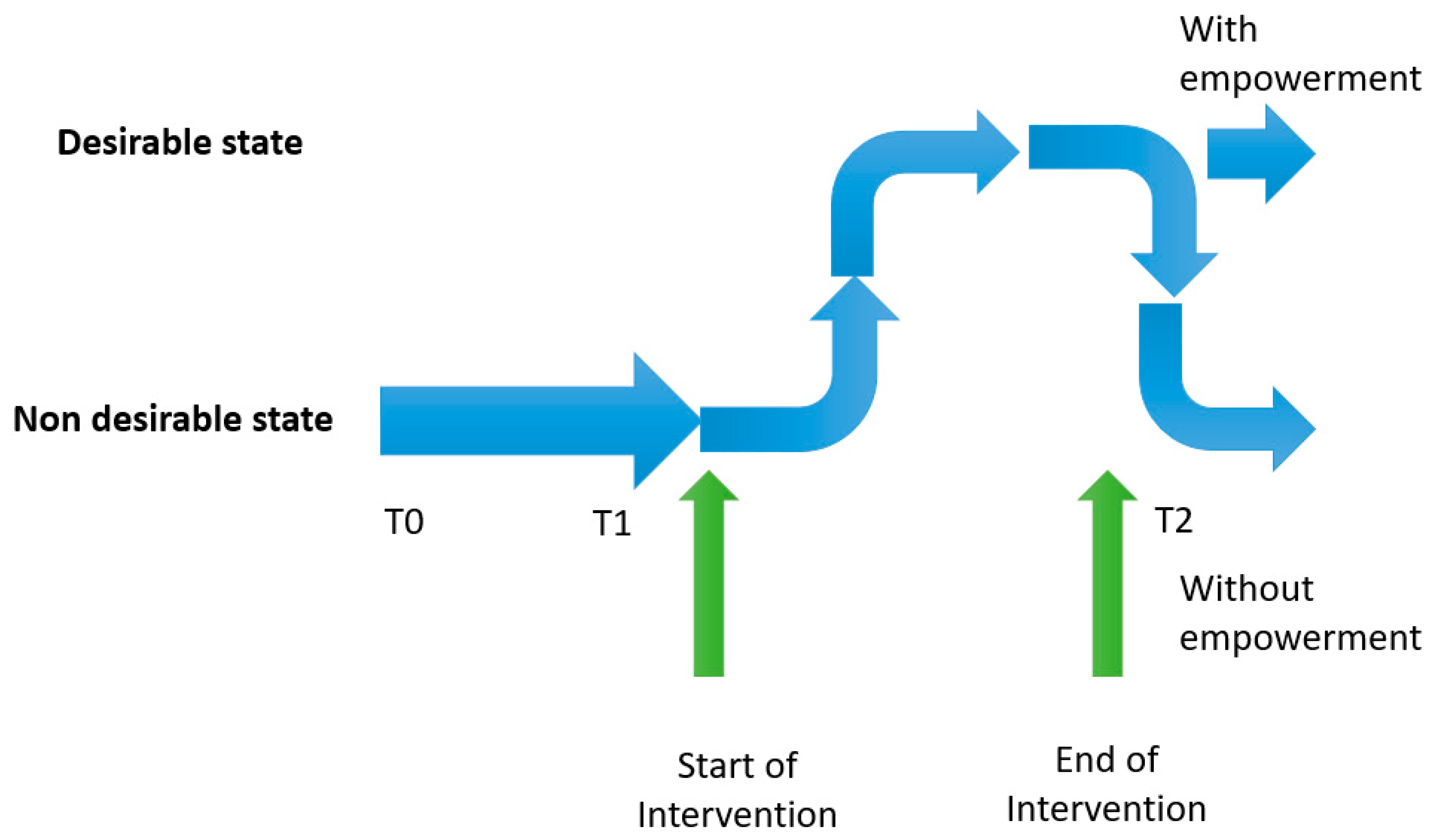
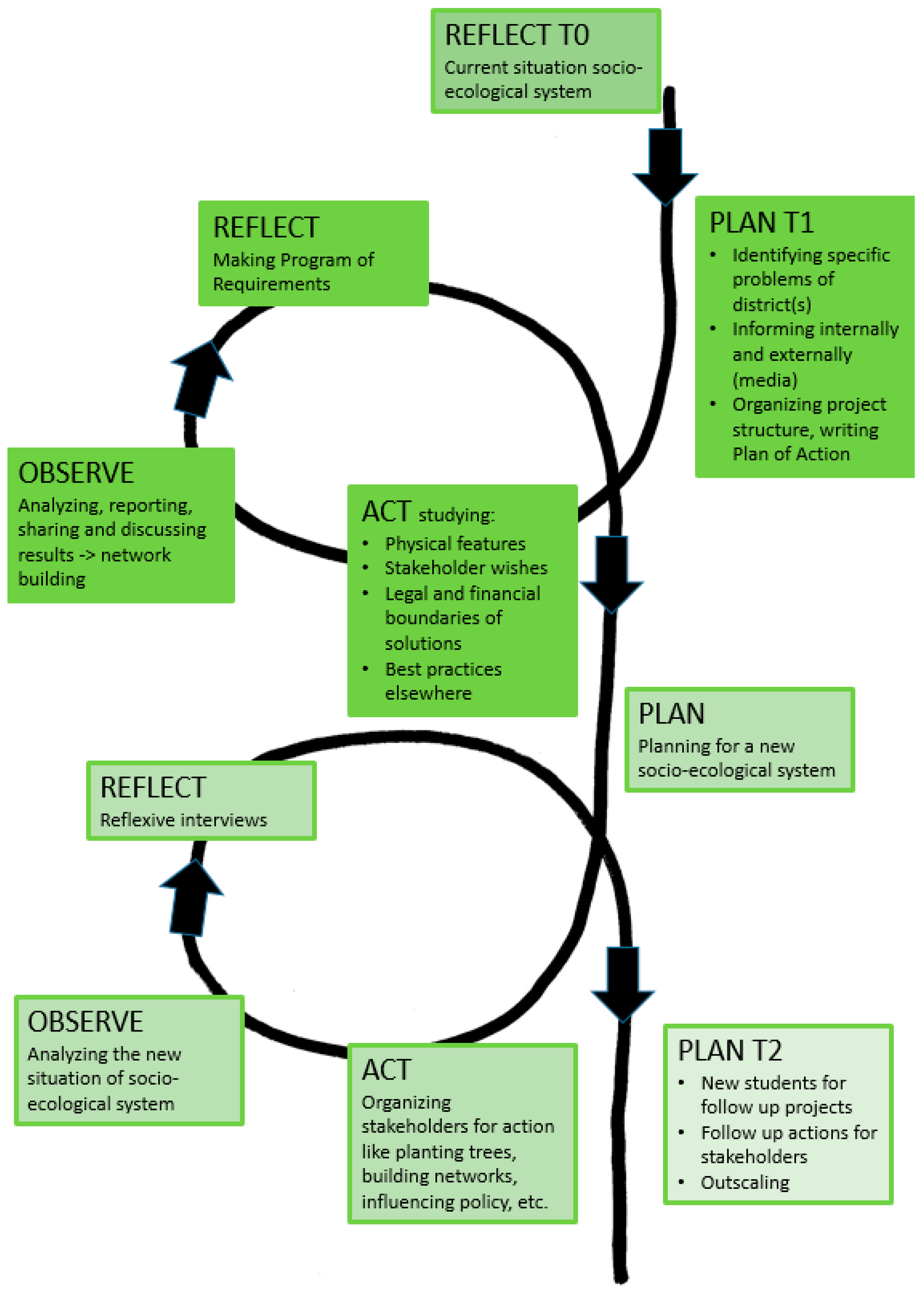
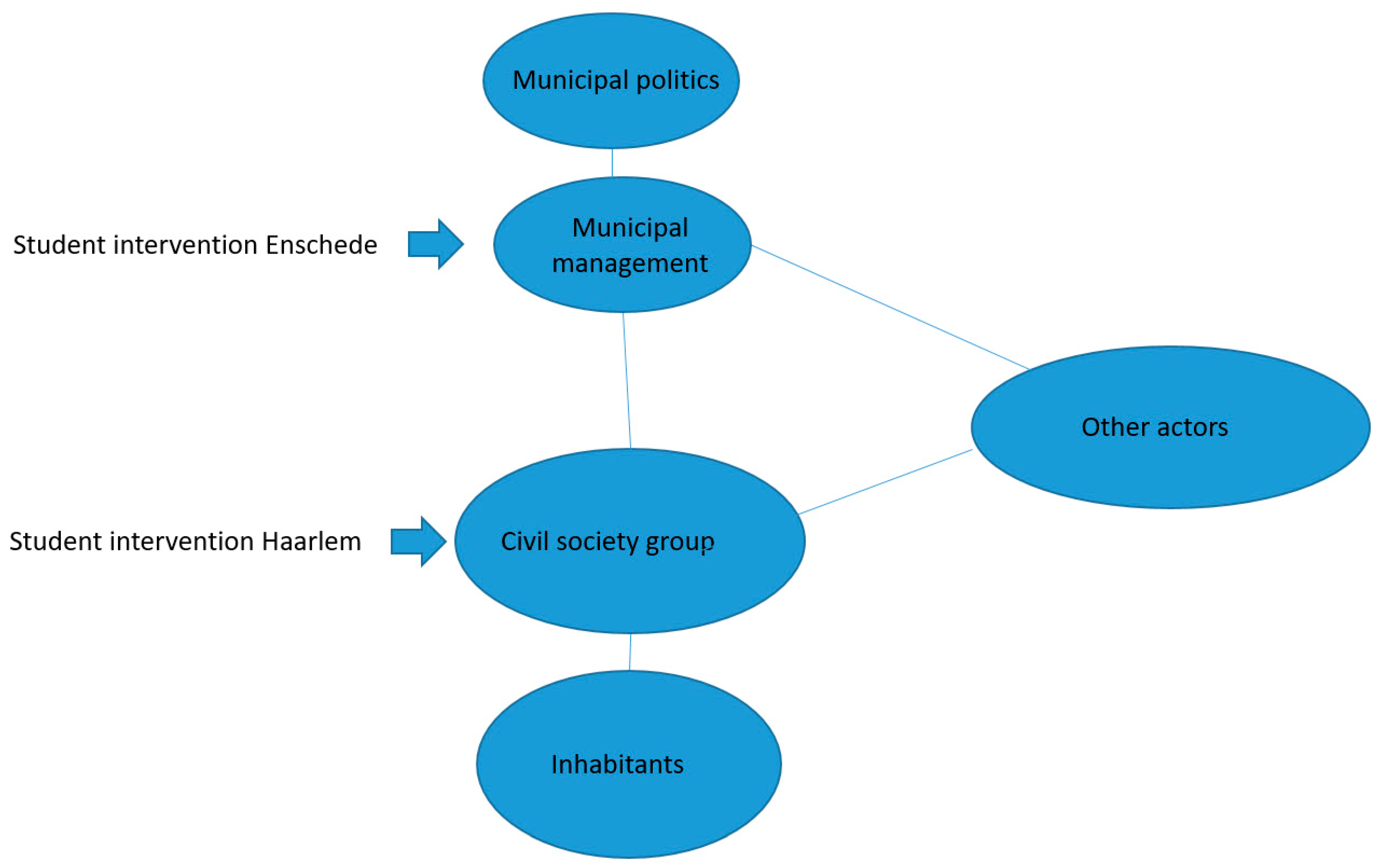
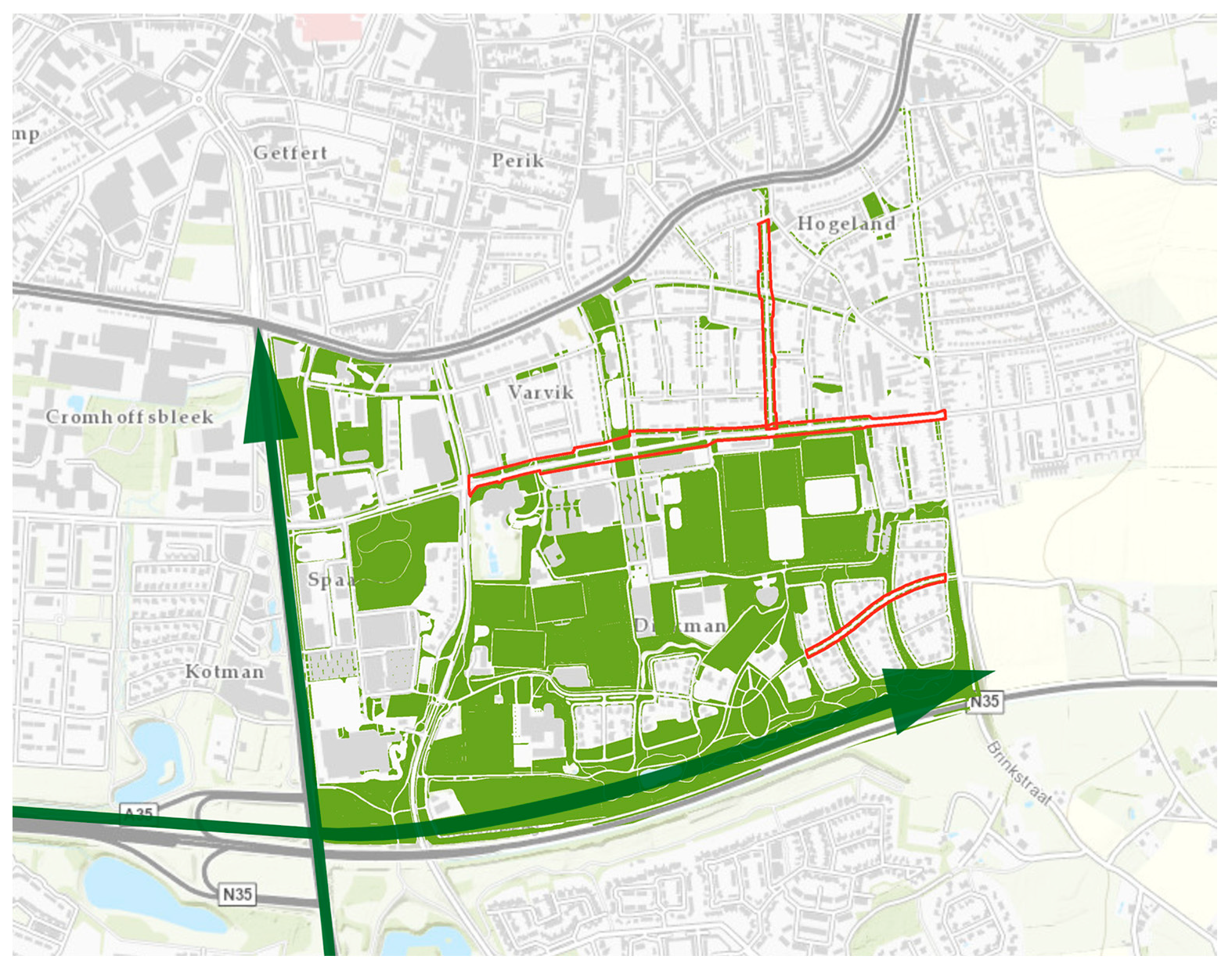
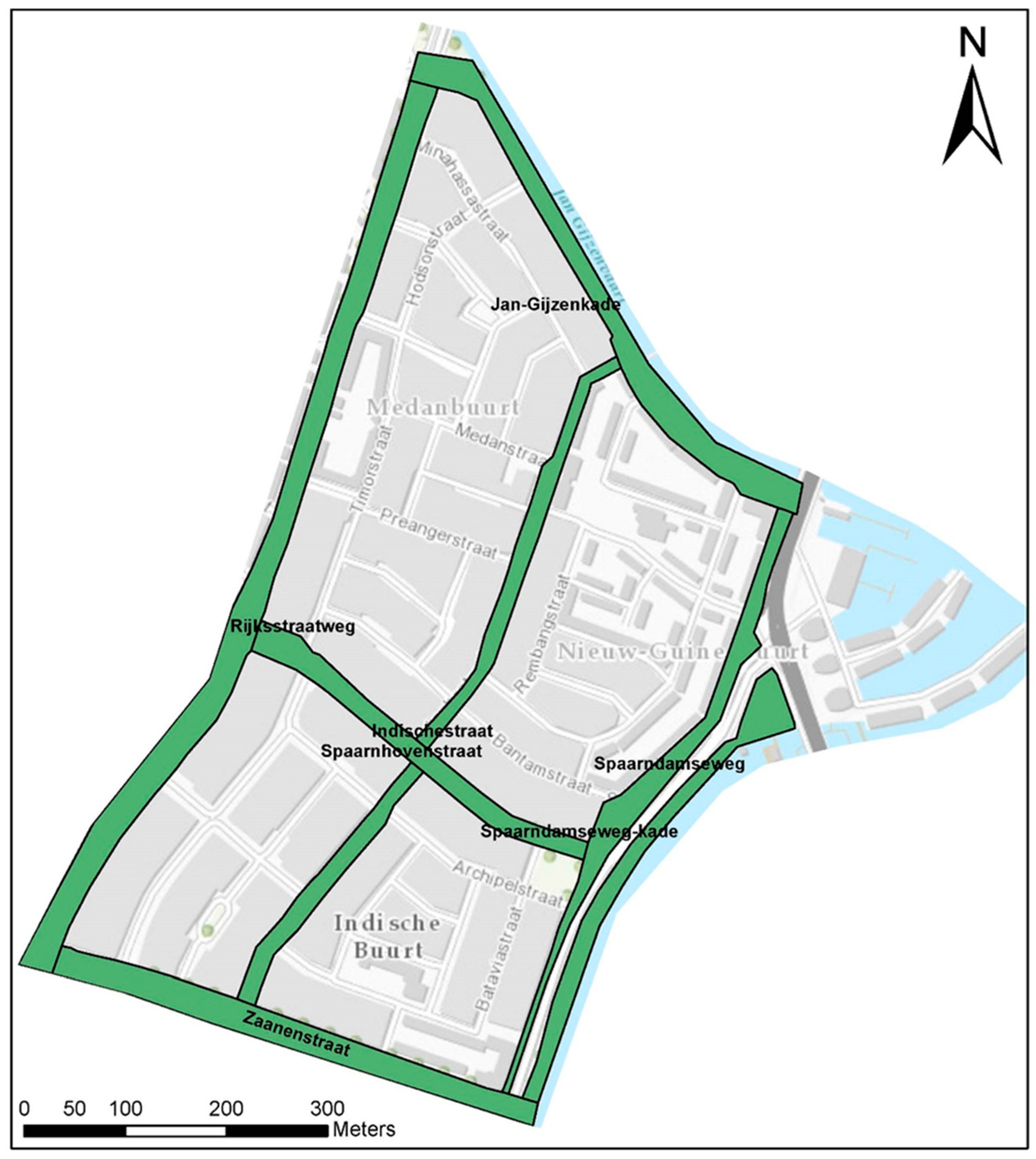
© 2020 by the author. Licensee MDPI, Basel, Switzerland. This article is an open access article distributed under the terms and conditions of the Creative Commons Attribution (CC BY) license (http://creativecommons.org/licenses/by/4.0/).
Share and Cite
Stobbelaar, D.J. Impact of Student Interventions on Urban Greening Processes. Sustainability 2020, 12, 5451. https://doi.org/10.3390/su12135451
Stobbelaar DJ. Impact of Student Interventions on Urban Greening Processes. Sustainability. 2020; 12(13):5451. https://doi.org/10.3390/su12135451
Chicago/Turabian StyleStobbelaar, Derk Jan. 2020. "Impact of Student Interventions on Urban Greening Processes" Sustainability 12, no. 13: 5451. https://doi.org/10.3390/su12135451
APA StyleStobbelaar, D. J. (2020). Impact of Student Interventions on Urban Greening Processes. Sustainability, 12(13), 5451. https://doi.org/10.3390/su12135451





